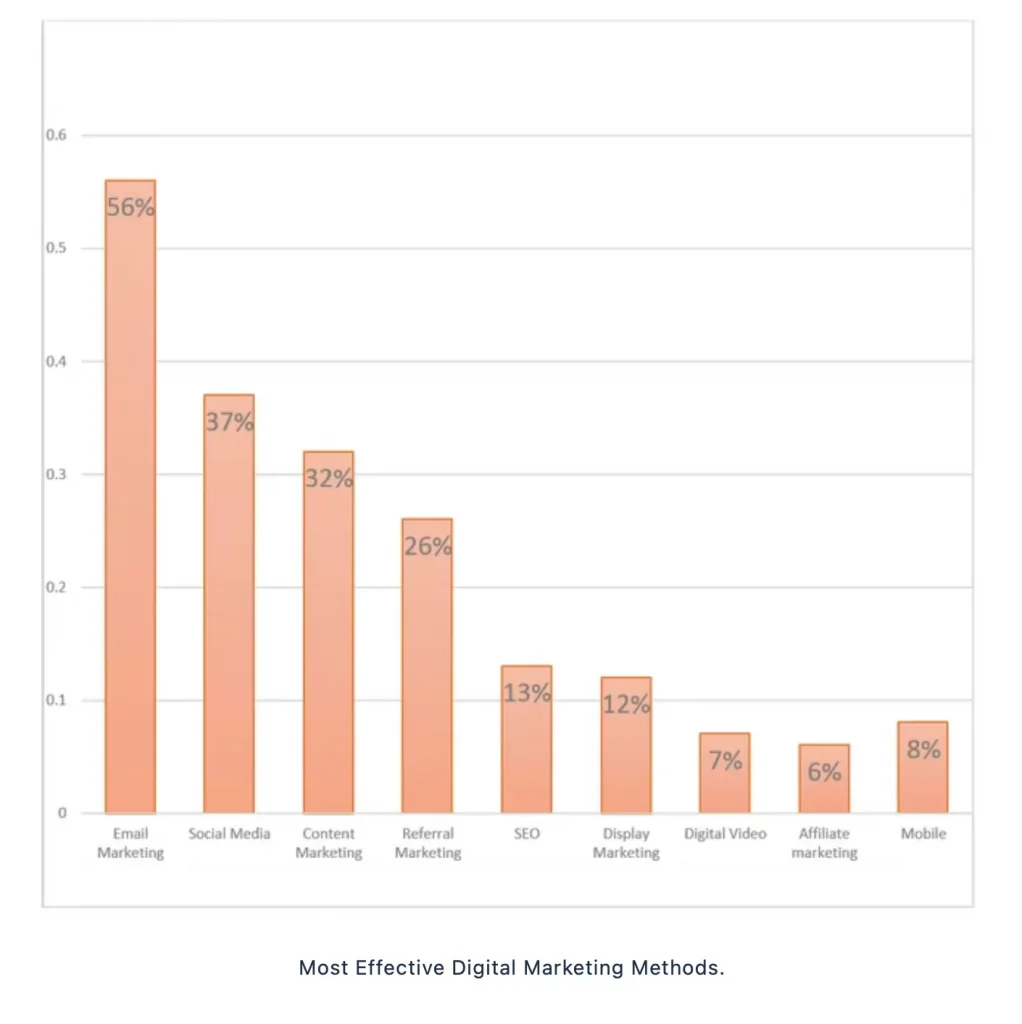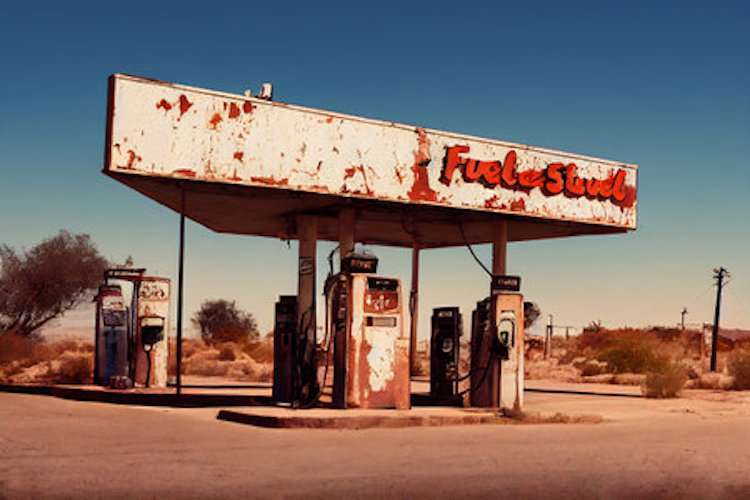There’s plenty of opportunity. But to be successful, you need to bring targeted traffic to your ecommerce store and maximise your brand visibility. You need to get eyeballs on your products. And there are a ton of ways to go about that. The only problem is that choosing the right ecommerce marketing channels is often easier said than done, especially when you’re just starting. It can be downright overwhelming. So how do you know where to focus your attention?
Here we outline what we feel are the most lucrative (ROI) ecommerce marketing channels for store owners based on key factors like simplicity, effectiveness, and how long it takes to get results. We’ll cover the essentials so you can get your digital marketing started on the right foot and ensure you bring a steady stream of quality traffic to your ecommerce store.
Ecommerce Statistics on Digital Marketing
Customer acquisitions and retention both require a strong marketing strategy. With businesses growing online, Social Media and social-media advertising have long since replaced press advertising and billboards. TV advertising remains a dilemma, it remains the most immediate medium, but lacks the volume audiences once enjoyed as the world has gone digital with pod-casts etc equally vying for audience attention. A lot of potential customers are redirected to ecommerce sites through social media.
Illustrated is the ranking of the most effective (lucrative) media channels currently used. (Source: Cleverbridge)

Hyper-personalised Email Product selection
It has long been appreciated that email marketing is by far the most lucrative (cost-effective) go-to marketing medium available. Universally published statistics tend to suggest a range from 26 – 34% of the entire turnover being derived from it if not more.
It has become much more sophisticated in the last few years. Indeed you don’t even need to segment your email audience any longer if you use predictive personalisation product selection software (PPS).
It imports all the buying history to learn and appreciate each consumer, and then it perpetually captures impressions that each individual ever makes on your site, to learn and appreciate every nuance and subtlety about that consumer’s potential buying propensity.
Unlike standard emails (segmented), hyper-personalisation software sends content analysed as the most relevant to the recipient. Delivering that content, regardless of distractions, unlike standard email software, which uses trivia like location, age, and culture. Hyper-personalisation software is based on products identified that are most likely to be, not only the most interesting to that individual recipient but have their highest potential buying propensity – what they are going to buy next. Check to see if the software you are considering, segments rather than ranks highest buying propensity, which is the first clue to experiencing much lower returns.
You don’t have to worry about landing pages, as each product is linked to a facility to simply load it to the basket. Cutting out superfluous elements that while they look good, or fit in with the pleasantries of a campaign being run, cause distraction and lack of singular attention to the purpose at hand.
Yes, to selling products to make a profit, yes to captivating the consumer with your agility to always keep “on the money” in what you offer them, and yes to your appreciation of that individual’s needs, wants and desires. Yes, to maximising the customer’s lifetime value. and yes to increase their average order value. Linking them to the specific page where their product is (rather than the generic homepage) increases the likelihood of them taking action.
It works best running alongside typical ESP software, but the distinction is best illustrated in the lucrative additional revenues enjoyed. Of course, the layman’s interpretation of personalisation – the email subject lines and their name (groan – so obvious) is included. It is a lot more than just getting their name right.
Video Marketing
We are big believers in the power of visuals. After all, “90 % of the information processed by the brain is visual,” and the human brain processes images 60,000 times faster than text.” One of the best ways to capture the attention of your audience is to dazzle them with visuals and show them what your product looks like, how it works, what its features are, and so on.
And there’s arguably no better way to do that digitally than through video. By implementing this channel, you’re on a medium that most people already watch like crazy. “By last year, online videos will make up more than 80 % of all consumer internet traffic (85 % in the US).” Not only that, “78 % of people watch online videos every week, and 55 % view online videos every day.”
So this is one of the best ways to quickly make a splash when you’re just breaking into the e-commerce world. What I love about video marketing is the plethora of different ways you can go about it.
Here are just a couple of examples of ecommerce brands that have pulled it off flawlessly.
First, there’s Onzie, a company that sells activewear, yoga, and workout apparel.
They have a “videos” page on their site that features about 20 videos of their products in action. The one at the very top serves as an introduction and includes a handful of their most popular products.
Content Marketing
Technically, video marketing is content marketing, but it’s a very specific type of medium. But for this channel, I’m referring to any other type of material, which can be extremely far-ranging.
Some examples include:
- Blog posts
- Guest posts
- How-to articles
- Infographics
- Guides
- eBooks
- Interviews
- Checklists
- Podcasts
- Stories
Even GIFs and memes can potentially be forms of content that help generate traffic. And the majority of e-commerce store owners can vouch for content marketing as being effective. In fact, “72 % of marketers said that having a good content strategy was a major key to their success in 2018.” There’s a lot to love about this channel, but in particular, I like that it allows you to reach your audience in a way that’s natural and unobtrusive and that it’s free/cheap.
In most cases, a well-run content marketing campaign is more of a time investment rather than a financial one. So if things are a little tight when you’re starting, this is a channel that should be on your radar. To give you a better idea of the nuts and bolts of how it works, allow me to provide you with an example of a brand that uses content marketing brilliantly. ![]()
The key to having success with content marketing is to keep your material hyper-relevant to your audience and ensure they always walk away with something useful. As long as you do that consistently, you should be able to gain traction and get shoppers interested in your content, which ultimately gets them interested in your products.
Influencer Marketing
There are two main things to aim for when running an e-commerce marketing campaign—results and a solid ROI. When done correctly, influencer marketing delivers just that. If you’re unfamiliar with the concept, it’s defined as “a form of marketing that focuses on targeting key industry leaders to drive brand message and awareness to a specific market of consumers.”
For instance, you might have a YouTuber with a sizable following feature one of your products in a video. Or you might have someone popular on Instagram show it off in one of their posts. And it’s been proven to get results. According to recent data, more than 9 out of every 10 marketers who use influencer marketing (93 %) report that it helped them gain visibility.
In terms of average ROI, every dollar spent on influencer marketing equals $6.50 in sales—roughly 11X, the ROI of traditional forms of digital marketing. It’s hard to argue with those numbers, and I think it’s one of the best e-commerce marketing channels for bringing instant exposure to your brand.
Case in point—CLIO Makeup, a Korean-based cosmetics company.
They’ve done a great job at generating exposure by partnering with Instagram beauty influencer Ya Stacey, who currently has 209k followers.![]()
Pay-Per-Click Advertising
Pay-per-click (PPC) advertising is a straightforward marketing channel where you pay a publisher like a search engine or website each time a visitor clicks on one of your ads. While PPC doesn’t have the same ROI as influencer marketing, it’s still respectable with an average rate of 200 %.
It’s also worth noting that “traffic brought through PPC advertising yields 50 % more conversions than organic advertising.” That’s because shoppers who click on an ad tend to have a higher interest level than when they’re just casually browsing. So you can recoup your money in a hurry and potentially crank up sales with this channel. Another big plus is how quickly you can bring in traffic.
If you get your campaign set up correctly, you can bring in targeted shoppers overnight. This makes PPC a good option if you need to get the ball rolling right away. And don’t think you’re limited to just Google AdWords and Facebook Ads. While these are often the first networks that come to mind, there are plenty of alternatives—many of which have a much lower average cost-per-click.
For instance, there’s Instagram Ads, which allows you to create a variety of eye-popping ads like images, videos, and carousels.
Conclusion
Successful ecommerce can be incredibly exciting and, due to the last couple of years, the industry is starting to hit its stride. However, navigating the marketing aspect can seem daunting with so many different options to choose from. At the end of the day, you need a streamlined approach that allows you to get in front of your target audience and effectively promote your products without wasting time and money.
The ecommerce marketing channels we listed here should help you do that with minimal friction so you can keep the traffic flowing while improving conversions.
That way, you can stand out from competitors and set the stage for long-term success.





